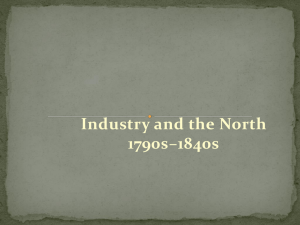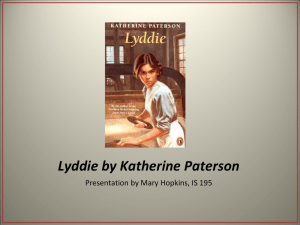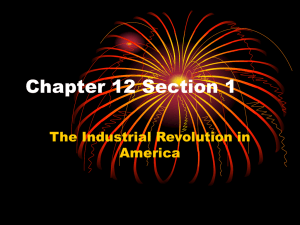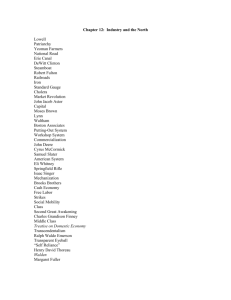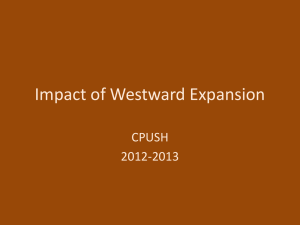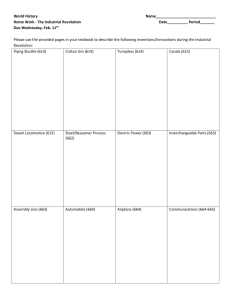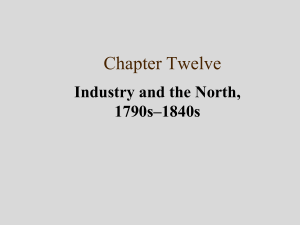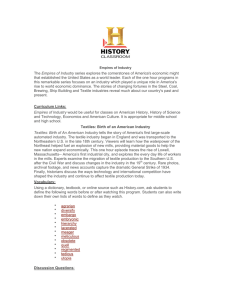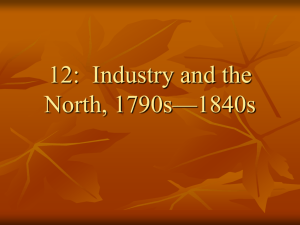AP US Ch 12 Questions
advertisement
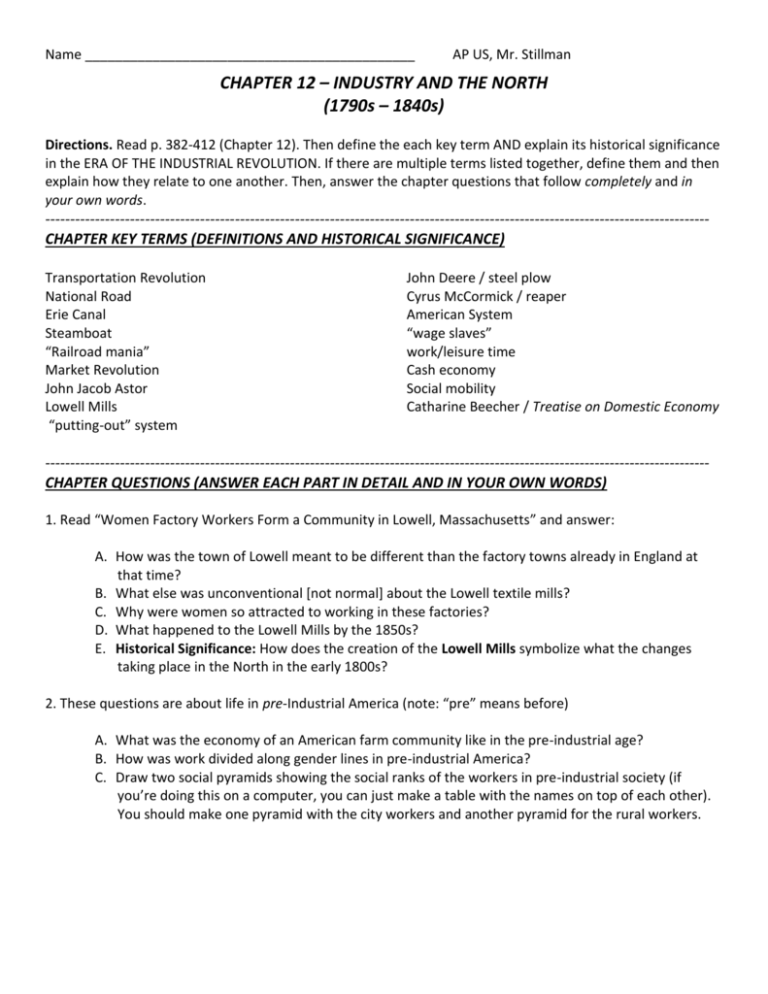
Name ____________________________________________ AP US, Mr. Stillman CHAPTER 12 – INDUSTRY AND THE NORTH (1790s – 1840s) Directions. Read p. 382-412 (Chapter 12). Then define the each key term AND explain its historical significance in the ERA OF THE INDUSTRIAL REVOLUTION. If there are multiple terms listed together, define them and then explain how they relate to one another. Then, answer the chapter questions that follow completely and in your own words. ------------------------------------------------------------------------------------------------------------------------------------CHAPTER KEY TERMS (DEFINITIONS AND HISTORICAL SIGNIFICANCE) Transportation Revolution National Road Erie Canal Steamboat “Railroad mania” Market Revolution John Jacob Astor Lowell Mills “putting-out” system John Deere / steel plow Cyrus McCormick / reaper American System “wage slaves” work/leisure time Cash economy Social mobility Catharine Beecher / Treatise on Domestic Economy ------------------------------------------------------------------------------------------------------------------------------------CHAPTER QUESTIONS (ANSWER EACH PART IN DETAIL AND IN YOUR OWN WORDS) 1. Read “Women Factory Workers Form a Community in Lowell, Massachusetts” and answer: A. How was the town of Lowell meant to be different than the factory towns already in England at that time? B. What else was unconventional [not normal] about the Lowell textile mills? C. Why were women so attracted to working in these factories? D. What happened to the Lowell Mills by the 1850s? E. Historical Significance: How does the creation of the Lowell Mills symbolize what the changes taking place in the North in the early 1800s? 2. These questions are about life in pre-Industrial America (note: “pre” means before) A. What was the economy of an American farm community like in the pre-industrial age? B. How was work divided along gender lines in pre-industrial America? C. Draw two social pyramids showing the social ranks of the workers in pre-industrial society (if you’re doing this on a computer, you can just make a table with the names on top of each other). You should make one pyramid with the city workers and another pyramid for the rural workers. 3. The Transportation Revolution: A. What was the symbolic significance of federal government’s building of the National Road? B. Why was the completion of the Erie Canal so unbelievably impressive? And why was it so important for the United States? C. What effect did the invention of the steamboat have on the United States? D. What early problems did railroads have? E. What do you think were the biggest effects of the Transportation Revolution on the American economy and society? 4. The Transportation Revolution had HUGE effects on Americans ability to travel quickly. Using Map 12-1 on p. 386 (and any other map you need), answer the following: A. B. C. D. E. How much quicker could you get from New York to Washington, D.C. in 1857 compared to 1800? How much quicker could you get from New York to Chicago in 1857 compared to 1800? How much quicker could you get from New York to Cincinnati in 1857 compared to 1800? How much quicker could you get from New York to New Orleans in 1857 compared to 1800? How much quicker could you get from New York to St. Louis in 1857 compared to 1800? 5. The market revolution was the result of what three interrelated developments? Explain what each of these developments actually was in detail and in your own words. 6. How did the South’s cotton boom actually help the Northern economy tremendously? 7. Why have American entrepreneurs and businessmen always been so willing to “think big” and take huge risks with their capital [investment money]? 8. What was the putting-out system and how did it fundamentally transform American manufacturing? 9. How did new advances in transportation help America’s agricultural economy enormously? 10. How did Samuel Slater and Francis Cabot Lowell advance American industrialization? What do you think of what they did? 11. How did the British mills respond to competition from the new textile mills popping up in New England? How did the American government respond to the British move? What part of the country did this action by the US government end up hurting? (Note: Think back to Chapter 11) 12. What was so smart about the American system of interchangeable parts? Why do you think it gave Americans such pride? 13. Why did men in the north oppose female workers entering the workforce? 14. As the technology improved in the textile industry, what happened to the conditions for the workers in the factories? Why would this be true? 15. How did the market revolution change ordinary peoples’ everyday lives? 16. How successful were the earliest strikes by factory workers? Why was this the case? 17. How did the market revolution change the social class structure in America? (be specific, explain what it was before and what it became) You may draw a chart/diagram/pyramid for your answer if you prefer. 18. How did the market revolution affect inequality in the United States between 1828 and 1845. Give specific statistics in your answer. 19. What values and personal life decisions were promoted by the new middle class about the following topics: A. family B. religion C. sex/pregnancy D. childhood E. gender roles in the family Bonus I: What second-rate college did Moses Brown found based on his profits from the iron, candle, rum and slave trade? Bonus II: Complete the following chart showing each region’s new agricultural specialty (in the first half of the 1800s). Region Ohio Upper Midwest (Indiana, Illinois, Michigan) Agricultural Specialty

